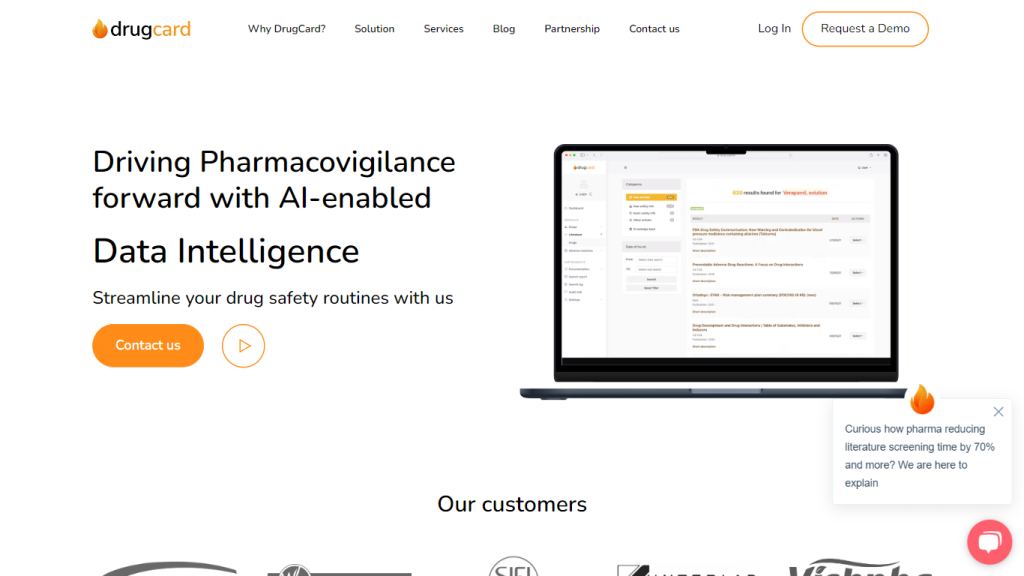What is DrugCard?
DrugCard is a new, AI-driven data intelligence solution for smoothing drug safety routines in the domain of pharmacovigilance. The solution handles some of the many issues this industry is facing, such as rising regulatory pressures and growing people costs, alongside increased continuous, regular, transparent control over drug safety processes. Combining local literature screening processes through natural language processing algorithms, DrugCard ensures that its process will be automated and simplified to make it more efficient and cost-effective.
Key Features & Benefits of DrugCard
DrugCard offers features and benefits that make it a solution of choice for many professionals working within drug safety and pharmacovigilance:
-
Automated Routine Drug Safety:
DrugCard automates routine screening of drugs in safety, reducing the effort of manual labor and reducing time investment. -
Multi-Language & Multi-Country Support:
It supports more than 100 languages, thereby covering medical journals from 45+ countries to provide complete coverage. -
High-Performance Screening:
State-of-the-art screening methodologies are in use within DrugCard to return results that are accurate and complete. -
Transparency and Traceability:
Detailed reports and summaries give clear insights into the screened literature, enhancing transparency and traceability. -
Real-Time Notifications:
New literature and important developments are flagged and updated in real time to the user. -
Cost-Effective:
By cutting down on manual efforts and resources required, DrugCard offers a cost-effective solution for local literature screening.
DrugCard Use Cases and Applications
In this respect, such versatility makes DrugCard easy to apply in many different contexts in pharmacovigilance and drug safety:
-
Efficient Screening and Monitoring of Drug Safety:
Automating screening saves a lot of time and guarantees accuracy in the process. -
Compliance with Evolving Regulatory Requirements:
The user is enabled to be compliant because of traceable and transparent processes. -
Time-Saving for the Pharmacovigilance Specialist:
Saves up to 70% of time previously spent on manual literature screening.
The tool is used by a wide array of professionals in the following areas:
- Pharmacovigilance professionals
- Drug safety specialists
- Clinical researchers
- Medical journalists
How to Use DrugCard
The usage of DrugCard is easy and intuitive. Here is how to do it, step by step:
-
Sign Up:
Log in and create an account on DrugCard’s official website. -
Set Up Preferences:
Set your screening preferences. You can set languages, countries, specific journals, etc. -
Initiate Screening:
Begin the screening process. After this step, AI algorithms of DrugCard will start performing the literature analysis. -
Get Updates:
Real-time notifications and alerts for new literature and important updates. -
Review Reports:
Detailed reports and summaries to understand and interpret the results.
For the best results, it is recommended to update your preferences regularly and review the alerts and reports provided by DrugCard from time to time.
How DrugCard Works
DrugCard operates on advanced NLP algorithms that scan and analyze a huge amount of scientific literature. The workflow involves:
-
Information Gathering:
This involves the collection of articles on science from various journals and databases. -
Processing:
The information obtained from the data collected is filtered through NLP algorithms. -
Analysis:
Analyzing the filtered information to give the main information on drugs, their impacts, and possible drug interactions. -
Reporting:
Reports and summaries clearly indicating an understanding of the findings.
Pros and Cons of DrugCard
DrugCard, like any other tool, has its share of pros and cons:
Pros
- Saves time and resources since it automates the screening process.
- It supports different languages and countries, thus offering complete coverage.
- Results are transparent and traceable through comprehensive reports and summaries.
- Saves time with a cost-effective solution, instead of extensive manual labor.
Possible Cons
- Initial setup and configuration take some time and effort.
- Depending on AI algorithms may miss certain nuanced information that sometimes requires human interpretation.
Conclusion about DrugCard
DrugCard is a fine tool for local literature screening in pharmacovigilance, as this allows for automation, multilingualism, and high performance while ensuring low cost. This helps the industry tackle challenges regarding compliance with regulatory requirements and saving time and resources.
As pharmacovigilance is going to continue to increase, DrugCard would have to keep up and provide the user with the latest developments so as not to miss any vital detail. Further development and updates will make this tool even more advanced and turn this into a real backbone for every drug safety professional.
DrugCard FAQs
-
What is DrugCard?
DrugCard is an AI-driven data intelligence tool that helps in smoothening drug safety routines of pharmacovigilance through automating the local literature screening processes. -
How does DrugCard work?
It provides detailed reports and summaries based on the information read through scientific literature using advanced NLP algorithms. -
Who can use DrugCard?
This tool is useful for professionals working in pharmacovigilance, drug safety specialists, clinical researchers, and medical journalists. -
What are the pricing options for DrugCard?
DrugCard features a freemium model with basic features available for free and premium ones at a certain cost. -
What are some key features of DrugCard?
Some of the key features of the DrugCard include the automation of drug safety routines, support of multilanguage implementations, high-performance screening, transparency, real-time notifications, and it is cost-effective.









